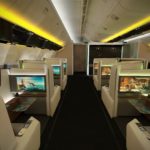As 2017 draws to a close Editor in Chief Alan Peaford looks back over an eventful year for the industry and looks at what to expect in the next 12 months.
I was fortunate to sit at lunch with Michael Ryan, the president of Bombardier’s Aerostructures and Engineering Services business, in London last week. Ryan had just walked across Hyde Park where the massive Winter Wonderland was in full swing.
“I don’t like roller coasters very much,” he said.
After the year that the Canadian manufacturer has experienced, Ryan is certainly familiar with them.
Throughout the past 12 months, Bombardier has been under intense pressure. It had cut costs and delayed some of its business aviation programmes to focus on the CSeries. Despite the aircraft getting rave reviews from the airlines that had taken the risk and ordered the narrow-body, there was still a dearth of customers. One major customer was Delta, but Boeing – and some of Delta’s competitors – felt that the price Delta paid was below cost price, and that this was only possible because of unfair government subsidies and therefore constituted an unfair subsidy. This resulted in the US government preparing to slap a 299% tariff charge on the import of the aircraft from Montreal.
Bombardier looked doomed and many feared it would force the company into Chinese hands. However, Airbus stepped in to take 50.01% of the company. With plans to build the aircraft in the US, for now all is right with the world.
Where next?
But it will be way into 2018 before the deal is finalised and until then the CSeries competitors from Embraer (whose CEO, John Slattery, says he will be watching like a hawk) and Boeing will be doing all it can to gain advantage before it goes through.
There is still a huge risk going forward. It may be that eventually Airbus will own the whole stock in the programme but many will remember the last time an airframer acquired an orphan aircraft. Boeing bought McDonnel Douglas for its MD-95, renaming it the Boeing 717-200. However, despite the fact it was a very popular aircraft with those who bought it, it always remained outside of the family of the 737s and very quietly died a death.
Airbus is confident that the CSeries will be adopted into its family of narrow-bodies and provide a real entry-level for its products as well as being a stand-alone success.
Embraer, who will be bringing the E2 jets to market during the first half of 2018, also sees the CSeries as an opportunity to demonstrate the advantages of its new aircraft as it delivers on time.
Boeing and Airbus
Boeing has had a pretty good year. At Paris Airshow it pulled in the crowds with debuts for the 787-10 and the 737-900 MAX, it also gave a glimpse of its new middle market plans with aircraft dubbed the 797 by the watching media.
And as the aerospace show circus headed to Dubai last month, Boeing held a healthy lead over Airbus for orders in 2017, with around 65% of new order values. It then piled on the pressure with a $15.1 billion order for 40 787-10 Dreamliners for host carrier Emirates and a massive 225 737 Max narrowbodies worth $27 billion for Flydubai.
Airbus had been smarting over the breakdown of talks with Emirates for 35 A380s – a deal that both Airbus and Emirates need to succeed if the A380 programme is to survive. On the final day of the Dubai show, Airbus executives flew back to announce its largest aircraft order ever with a $49.5 billion signing for 430 A320 jets from Indigo Partners’ portfolio of low-cost airline customers, leaving both airframers with a satisfactory order book for what everyone had anticipated would be a difficult year,
Competition from the East
However, although we all focus on the big four manufacturers, there is a prospect of greater competition from the East.
The Mitsubishi Regional Jet (MRJ) also had a roller coaster year. Showing the MRJ to the world at Paris in June was a high – and then a real low as it grounded its flight test fleet, following an engine “flameout” on one of its test prototypes on 21 August. It seems there was an “uncommanded shut down” of FTA-2’s left Pratt & Whitney PW1200G engine during a test flight.
Testing is now back on but the entry into service projection for the first 90-seat MRJ90 to launch customer All Nippon Airways is put back until mid-2020.
China has even grander ambitions. After making its maiden flight in May, the C919 jetliner flew more than 1,300 kilometers to the Yanliang testing base in Xi’an, Shaanxi province, in November for more tests. This competitor to the the A320neo and the 737MAX families will fly 156 to 168 passengers and already has 785 orders in hand. And while Boeing and Airbus may be put out by the progress being made, other members of the supply chain will be excited as manufacturer COMAC is making use of Western technology – including CFM’s LEAP engines – to power the project.
Watch out next year though, for more on another project from China. Collaboration with Russia.
The September launch of a joint venture between Moscow and Beijing to produce the CR929 widebody jet appears to be progressing well. This may well feature more Russian technology and could produce another headache for the Airbus-Boeing duopoly.
Into the unknown
But the real competition in the sector is likely to come from the unknown.
Aerospace has become an exciting arena for the new technologists, and the old regulated structures are facing disruption.
In 2018, we will be seeing far more of the existing aerospace giants focusing on the next generation of structures and systems. Airbus, Rolls-Royce and Siemens are developing a hybrid fuel system for commercial aircraft while aerostructures businesses will be announcing new lighter weight composites
Alternative transport methods will develop – during 2017 we saw the Volocopter prototype that will operate as an unmanned air taxi, and in other new digitalisation programmes the UAE plans to use a digital tunnel for air passengers to walk through with technology that would recognise them from their biometrics and allow them non-stop access. It is scheduled to begin operation in 2018.
So 2017 was not quite as bad as we feared and there were many pleasant surprises – 2018 already looks exciting. Just fasten your seatbelt and let the roller coaster ride begin.

